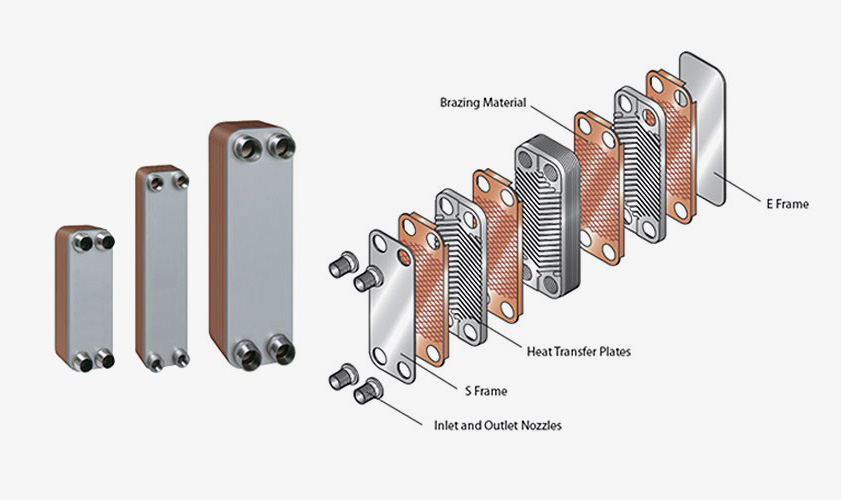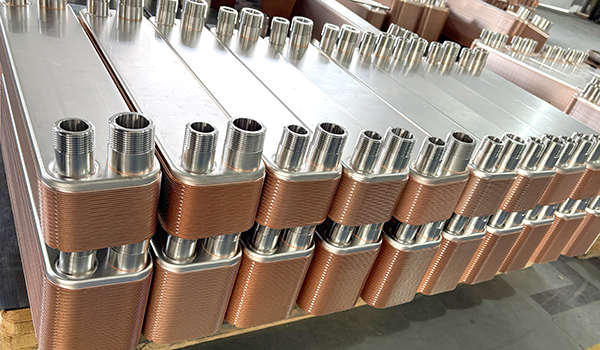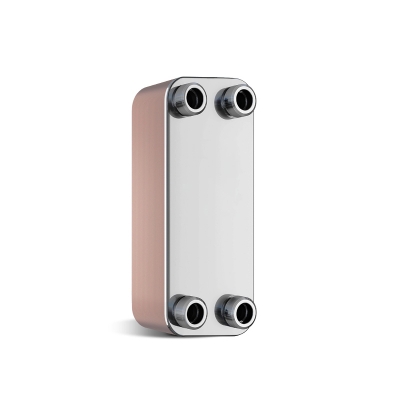| Name: | Brazed Plate Heat Exchanger |
|---|---|
| Type: | cooper brazed plate type |
| Plate Material: | Stainless Steel 304, 316L |
| Plate Thickness: | 0.4mm |
| Frame Material: | Carbon steel , Stainless steel |
| Design/Test Pressure: | 45bar/65bar |
| Design Temperature: | -160~200℃ |
| Inquiry |
Product Description
Brazed Plate Heat Exchanger

Brazed plate heat exchanger Advantage
Compact Structure and Easy installation
Light weight: 20% - 30% of shell-tube heat exchanger
Small consumption of water: only need 1/3 of shell tube heat exchanger water Durability: withstand high temperature 400 ℃ and high pressure 45 bar
Low scaling coefficient: high turbulence reduces scaling coefficient

Brazed plate heat exchanger Operation and Maintenance
Anti prevent clogging If foreign matters enter into the channel of the heat exchanger or the channel is seriously scaled, the blockage for channel will appear, when being used as evaporator, it will cause freezing and used as condenser, it will cause corrosion; both will damage the structure of heat exchanger and result in inner leakage. So it need to pay attention to the pressure loss change of medium before and after passing through heat exchanger, if pressure loss increases suddenly, it shall shut down to clean and maintain the heat exchanger in time, if necessary, the heat exchanger shall be replated to avoid greater losses.
Icing prevention
A. Use antifreeze when the vaporizing temperature is close to the freezing point of one side of liquid.
B. B. Prevent too little overfilling of refrigerant resulting in over-lower vaporizing temperature
C. Clean and maintain it at routine interval to prevent icing arising from blocking resulted from the scaling in heat exchanger pipes
D. implement soft treatment for water with higher hardness so that the icing is avoided as the heat exchanger pipes is blocked as a result of scaling.
E. Mount drainage devices and carry out evacuation treatment for non-service heat exchanger in such way that the icing is avoided inside the heat exchanger in such way that the icing is avoided inside the heat exchanger when the ambient temperature is too lower.
F. Mount and use the filter screen its mesh less than 1mm in such way the floccus, filaments and bigger sundries are prevented to entering the heat exchanger and the icing is avoided as a result of blocking inside the heat exchanger.
G. Mount water flowing switch for the purpose of guarantee of constant water flowing pre-, middle- and post-operation of compressor in order to prevent the hydraulic pump against shutting down emergently accidentally during in-processing system.
H. Mount low-voltage protection control switch to prevent against too lower suction pressure.
I. Mount protection controller for post expansion valve temperature, then shut off compressor when the post calve temperature is too lower.
J. Mount low-temperature protection controller for chilled water outlet for with cements of high temp-sensitivity.
K. Pay attention to avoiding the failure or delayed control of controller.
Corrosion prevention
A. In order to prevent corrosion heat exchanger against, if must be guaranteed that no affect of corrosion from the heat exchanger mounted and in-service environment as well as medium for exchanging heat on stainless steel metal and copper metal will take place(the content of chloride ion and sulfate ion in heat exchanging medium usually does not exceed 100mg/l)
B. Use the filter screen with mesh less than 1mm in such way the floccus, filaments and bigger sundries are prevented to entering the heat exchanger resulting in blocking.
C. Clean the scaling inside the heat exchanger in time.
D. Ensure that the system is in constant operation to prevent the plates of heat exchanger against strain corrosion resulted from the violent or frequent changes of pressure of system pipes.
E. The liquid into heat exchanger shall be fully drained when the system shuts down its operation and be in long-term non-service.
Cleaning
As for plate heat exchanger, the scaling will occur when the pressure drop increases during its operation. Clean the general oil scaling with cleaning agent; in case of serious scaling, clean it in reverse flow manner for 24 hours with chemicals nondestructive to stainless steel metal and copper metal)e.g. phosphoric acid with concentration of 5% or peroxide acid, mosquito acid, citrate, acetic acid, oxalic acid or other organic acids). When cleaning, control the flowing velocity of cleaning liquid by means of pump pressurizing and the optimum flowing velocity is 1.5-2 times of that of previous liquid. After completion of cleaning, wash the cleaning liquid in the system with plenty of cleaning water, prior to starting the system.

Various models Brazed Plate Heat Exchangers are available, welcome to inquiry at any time. aiks@aiksintl.com


 Send Email
Send Email